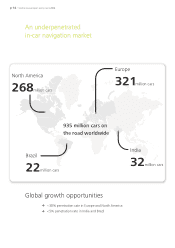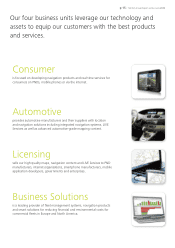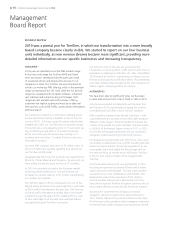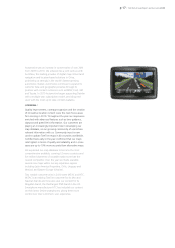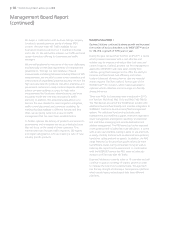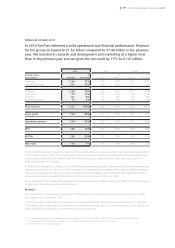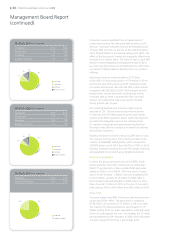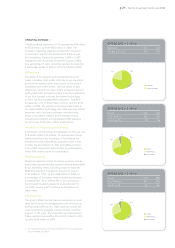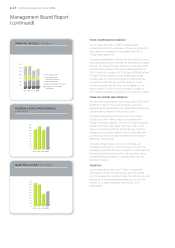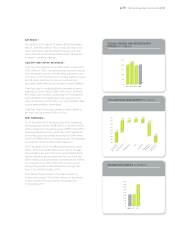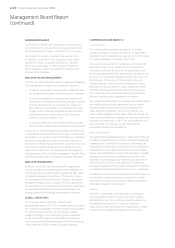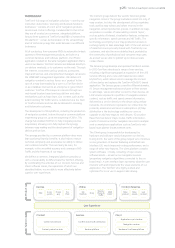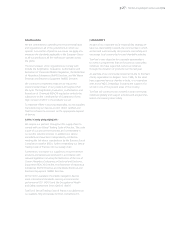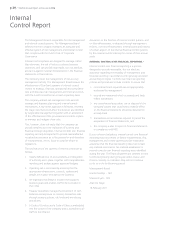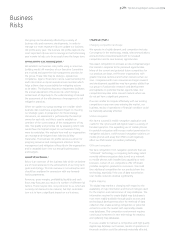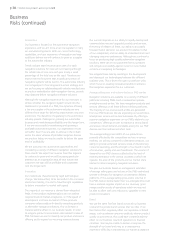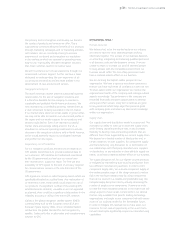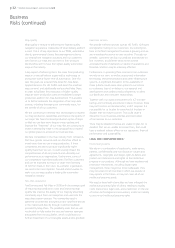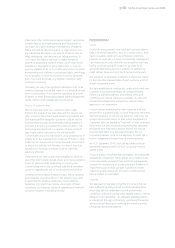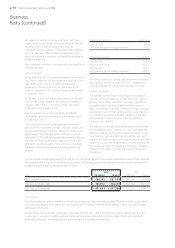TomTom 2010 Annual Report Download - page 26
Download and view the complete annual report
Please find page 26 of the 2010 TomTom annual report below. You can navigate through the pages in the report by either clicking on the pages listed below, or by using the keyword search tool below to find specific information within the annual report.p 24 / TomTom Annual Report and Accounts 2010
Management Board Report
(continued)
COMPENSATION AND BENEFITS /
Compensation
Our compensation programme supports our overall
company strategy. It consists of a mixture of base salary
and performance-related bonus, plus a long-term incentive
for certain employees in mission critical roles.
The goal is to provide a fair, competitive and responsible
base pay for each of our employees and to provide a
consistent worldwide framework of compensation and
benefits packages which also take local circumstances into
account. We introduced a globally uniform job matrix for
the company. The purpose of this project, known as
“global grading”, was to rank jobs internally by using a
fixed set of criteria so that we could compare all roles at
TomTom internally and externally. By doing so, we have
been able to provide cohesion between jobs located in
different business units, departments or regions.
As a result we can develop more transparent compensation
and benefits policies and programmes such as market
competitive pay ranges, personal bonus policies and
other benefits programmes such as our company car
policy. Global grading will also better allow us to map out
internal career paths for employees as well as an associated
competency framework. In 2011, we will continue to fine
tune this work, by evolving our job matrix and the
associated policies and programmes.
Bonus programmes
The performance-related bonus plan, which was introduced
in 2009, is a significant part of every employee’s total cash
compensation. It directly links company performance to
individual performance by creating a bonus pool based on
the realisation of annually determined financial company
targets. The available bonus pool is then allocated to eligible
employees based on their individual performance. The
target bonus percentages vary depending on the level of
influence each role has on the execution of TomTom’s
strategy. The plan fits with our vision that success for TomTom
as a business should also mean success for our employees.
In addition to this annual bonus plan we provide individual,
role-specific output bonuses as an incentive for certain
employees for areas such as patent creation, exceptional
individual recognition and referrals.
Benefits
TomTom is committed to providing all our employees
with competitive benefits in terms of pension, health
and disability cover. Our worldwide benefit programmes
therefore focus primarily in these areas. However,
depending on local circumstances and practices in certain
countries, some additional programmes are in place.
HUMAN RESOURCES
TomTom has 3,500 people working at over 40 locations
around the world. Our workforce is hugely diverse which
we believe has been a major contributor to our success.
Our passion for people is central to our culture. Work
at TomTom is centred on four core values; open spirit,
passion for results, innovative thinking and customer
driven. Our core values are at the heart of TomTom’s
talent acquisition, talent management, retention and
compensation strategies.
EMPLOYEE TALENT MANAGEMENT /
In 2010, we implemented our talent management strategy.
This strategy aims to deliver on several key objectives:
>to identify and support a ready pipeline of talent to take
on management positions and critical roles in the future
>to retain employees by providing career growth and
challenges for employees across the company. In terms
of career development we recognise our employees
have different career needs. For example 50% of our
people work in technical fields and we have therefore
created specialised career paths to allow for career
growth in technical streams, and
>to improve employee productivity by matching people
with their jobs, keeping them motivated and challenged.
As part of our talent management strategy, we introduced
a Talent Board comprised of senior executives to assist in the
development of succession plans and make key investment
decisions. During the year, these investments resulted in
the delivery of leadership development programmes for our
commercial and technology teams worldwide. We also
created and rolled out a new management development
training approach for our first line managers to provide them
with the necessary skills to manage employees effectively.
EMPLOYEE ENGAGEMENT /
As in prior years, the use of team specific engagement
surveys provided structured feedback from employees to
help identify priorities and enable managers to take action
to enhance employee commitment. The results provide
our management teams with useful feedback to improve
management action plans on topics like the organisation
of work, training, remuneration and workload. These plans
included the reallocation of work streams between our
business units and technology teams earlier in the year.
GLOBAL CAPABILITIES /
The employee base in TomTom is diverse and
geographically spread. In 2010, we made plans to increase
the number of employees involved in engineering activities
in Central Europe and India. We developed a global
location strategy for our engineering teams worldwide.
At the end of 2010, approximately 60% of employees
were based outside the Netherlands (15% in the Americas,
14% in APAC and 30% in other European locations).


